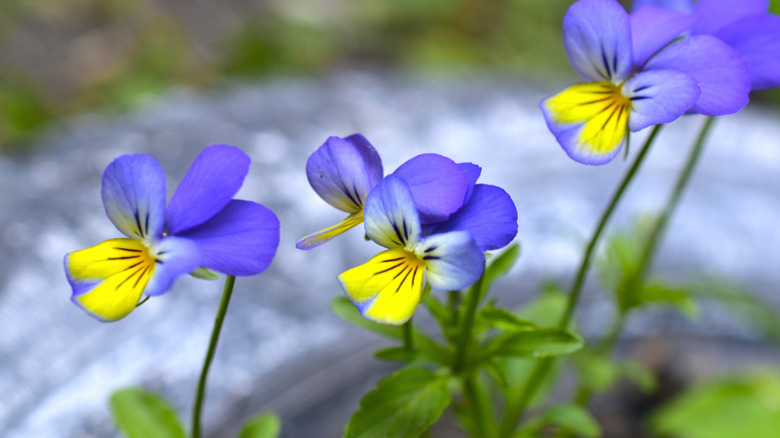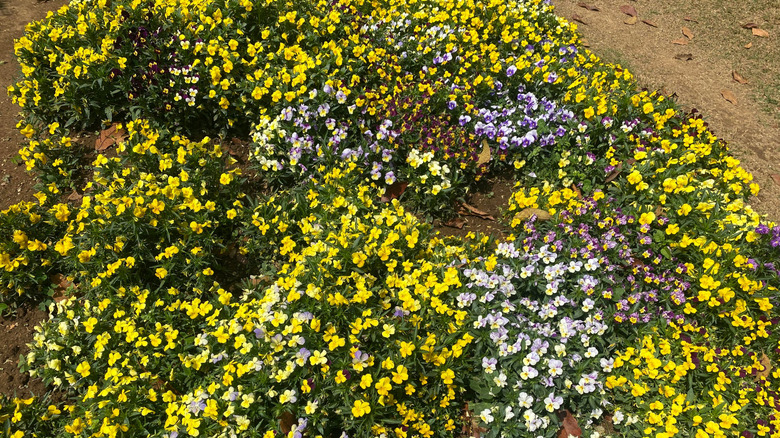The Purple Flowering Ground Cover That Makes A Stunning Grass Alternative
Keeping your lawn green and free from weeds can be a full-time job, and many homeowners prefer a ground cover with lower maintenance. These days, there's also a movement toward more pollinator-friendly grass alternatives that require less fertilizer and fewer weed treatments, marking increased concern for the environment. With a variety of grass alternatives you can grow instead of grass, the best option for your home should factor in your location, skill level, and needs.
That's where horned violet (Viola cornuta) comes in. While this plant sounds like a flower meant for adding color to your yard, it also makes a great grass alternative because it doesn't grow more than 6 to 9 inches high and thrives in USDA Hardiness Zones 6 to 11. Further, it's easy to care for and makes a great decoration in flower beds, as borders, and even in hanging baskets.
Horned violet's perks don't end there. This flowering perennial loves full sun or partial shade, making it a great fit for most lawns. Its seeds are typically dispersed by ants, meaning each 12-inch-wide plant quickly multiplies and spreads rapidly. Soon, you'll be able to ditch your lawn mower and kick back, watching new visitors — including bees, butterflies, and other pollinators — stopping by your backyard.
A beautiful ground cover with a devilish name
A member of the violet family, this horned species was likely named either for the top two petals that grow upwards, mimicking horns, or else the nectar spur that protrudes from the back of the flower. Horned violet is native to the Pyrenees mountain range which forms the border between Spain and France. These days, it can grow just about anywhere the climate is right.
Horned violet typically produces blue or purple flowers in cooler months of spring. Certain hybrids have white, variegated, and even golden blooms. But in the hottest of summer months, you won't see blooms. You can encourage more flowers by deadheading the plant. Unlike your typical grass cover, horned violets are highly susceptible to snails and slugs, which love to feast on the plant. Look for signs of these critters either in their sticky trails left behind or by spotting large holes in both the leaves and flowers of the horned violet. If things get out of hand, you can try an ingredient that'll control snails and slugs in the garden, like vinegar.
A note to keep in mind: Horned violets are technically in Viola, the plant genus that also includes pansies. While not all Violas are pansies, all pansies are Violas. The reason this matters is because as a less common flower, most of the advice on caring for horned violets comes from authorities on pansies. Remember this as you care for your new favorite ground cover.
Replacing your grass with horned violet
Swapping grass for horned violet is easy with the right tips and tricks for growing thriving ground cover plants in your yard. This perennial loves well-draining soil rich with humus, so the healthier your backyard soil is, the better. Most grasses, by comparison, tend to thrive in a broad range of soil types, which makes them versatile.
To get started, you'll need to first remove your existing ground cover. For a full lawn, pulling by hand won't make sense. Instead use herbicides or solarization, a technique in which you apply plastic sheeting to your lawn and let the sun heat and kill the plants underneath over a period of two to three months. This method is safest for the flora and fauna that might be harmed by herbicides. Once the grass is gone, prep the soil by breaking it up and removing leftover roots as well as any rocks. You can go above and beyond by adding fresh humus to the lawn to give your horned violet its best shot.
You'll want to baby your horned violet in its early stages. The plant may need help getting established by weeding neighboring plants to give it room. Once it takes hold, it should spread quickly, even working to choke out other weeds as it spreads. If you find that portions of the plant do well in one area of your yard, but poorly in another, it could be that sun and shade conditions aren't ideal in those areas. Try adding a second or even third ground cover species to the mix to ensure coverage in every corner of your lot.


